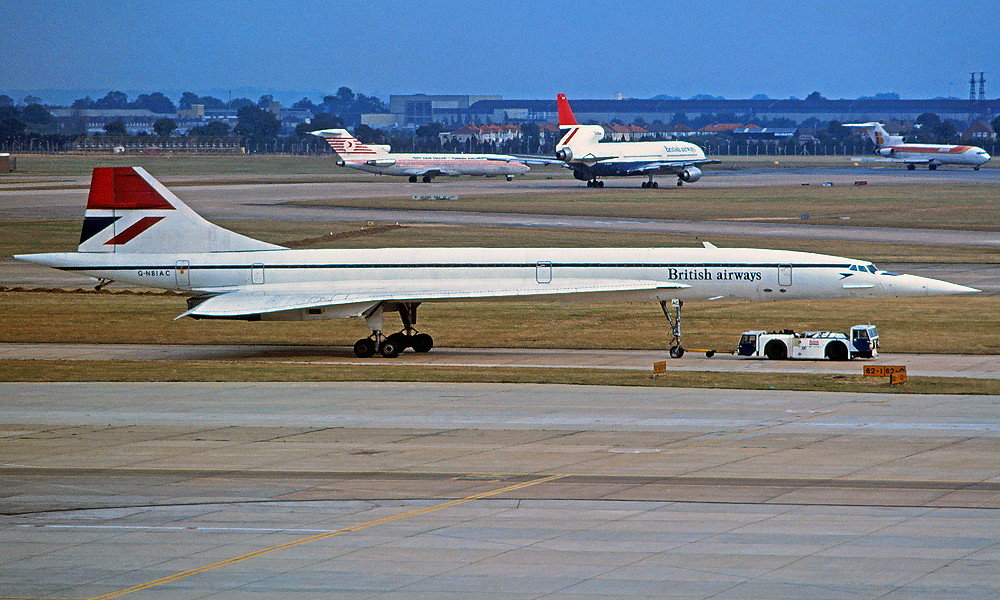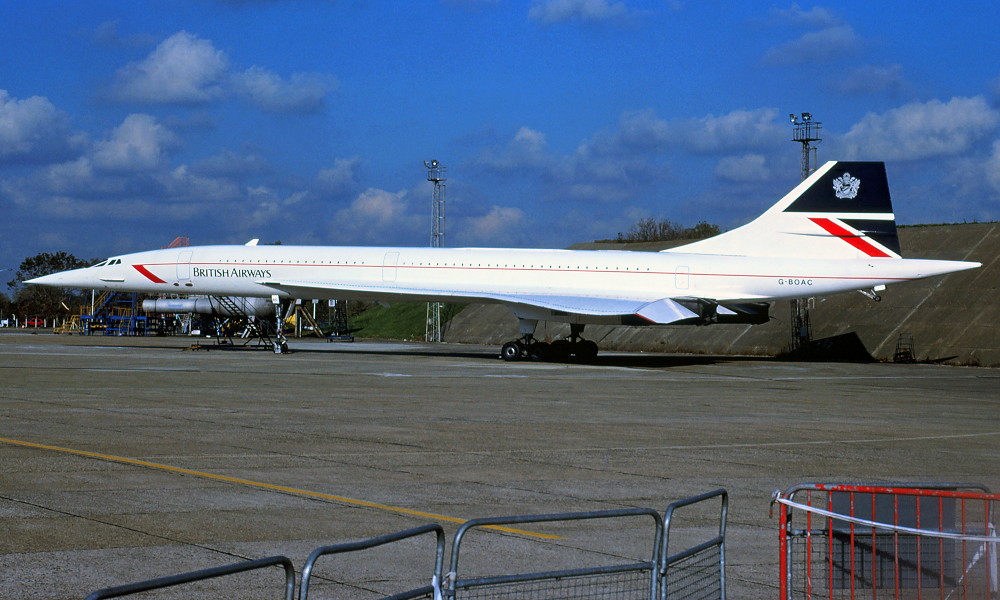G-BOAC. British Aircraft Corporation Concorde 102. c/n 204.
This aircraft was built by British Aircraft Corporation at the Filton, Bristol plant. It was entered onto the British Aircraft Register as G-BOAC (CofR R.14254) on April 3, 1974 and registered to the British Aircraft Corporation. It flew for the time from Filton on February 27, 1975 under the command of BAC Test Pilot, Captain Eddie McNamara. This aircraft was used initially by BAC to complete Certificate of Airworthiness items, such as air conditioning and auto landing trials. On completion of these tests in was used by British Airways on route proving flights around the world alongside the Air France aircraft F-BTSC. British Airways mainly based this aircraft at Bahrain but it also flew some services from Singapore. After completing some 141 flights it was returned to BAC in 1976 for refurbishment prior to being handed over to British Airways. Sold to British Airways onFebruary 3, 1976 its registration holder was subsequently amended. Officially handed over to the airline it was the oldest Concorde in its fleet, although not the oldest officially owned by British Airways (that honour falls to G-BOAA). It was also the heaviest airframe mainly due to the fact that it was one of the first built and the other Concordes had benefitted from the design being slightly altered and the weight being reduced as production proceeded. This aircraft was considered by the airline to be the flagship of the fleet as it carried the registration letters 'BOAC' which were the initials of the British Overseas Airways Corporation, the forerunner of British Airways. G-BOAC operated its first trans Atlantic revenue service from London (Heathrow) to Washington DC on May 26, 1976. It was re-registered G-N81AC / N81AC to British Airways / Braniff Airways on January 5, 1977 to comply with American registration requirements for the operation of the aircraft across continental USA. Following the aircraft's arrival at New York / Washington DC from London, the aircraft was used by Braniff Airways to fly its Washington DC / New York - Dallas Fort Worth service and return. It was returned to its original registration of G-BOAC and registered to British Airways on August 11, 1980 when the joint operating arrangement with Braniff Airways on this aircraft was terminated. This aircraft suffered a separation of the Number 3 Left Elevon on May 24, 1998. Five months later on October 8, 1998 it experienced a failure of the lower rudder wedge whilst flying from London Heathrow to New York JFK Airport. It was a new part that had only been fitted 4 years earlier to all seven British Airways Concordes. G-BOAC was lined up on the runway at London Heathrow Airport ready for takeoff to New York JFK on August 14, 2000 when the Civil Aviation Authority informed British Airways that the Certificate of Airworthiness was to be withdrawn the following day - August 15, 2000. G-BOAC was ordered to return to the terminal and all Concorde services were duly suspended. The cancellation of the Certificate of Airworthiness was the result of the crash of the Air France Concorde at Charles de Gaulle Airport, Paris on July 25, 2000. This accident resulted in all Concordes being grounded. G-BOAC was fitted with the 'return to flight' modifications that had been mandated by the aircraft's manufacturer and the relevant airworthiness authorities. The tyre manufacturer Michelin announced on June 7, 2001 that the tyres that were tested at Istres on the French Concorde F-BTSD would be fitted to all Concordes when they returned to service. On September 5, 2001 Certificates of Airworthiness were returned to modified Concordes by the British CAA and French DGAC. The CAA and DGAC announced that once each Concorde had been modified, its Certificates of Airworthiness would also be returned. It was the 5th aircraft in the British Airways fleet to have been modified. It returned to flight status on July 11, 2002. It flew the London - New York return service as BA001/002 on July 23 marking its return to passenger service. It operated its final revenue service on August 30, 2003 when it operated Barbados - London under the command of Captain Les Brodie. It had previously had the distinction of being the first Concorde to have visited the Carribean Island when it arrived there in 1977 to pick up Her Majesty Queen Elizabeth II at the end of her Jubilee Tour. Its final flight was a positioning flight from London Heathrow to Manchester Airport on October 31, 2003. It was placed on display in a glass hangar at the airport. On retirement G-BOAC had flown a total of 22,260 hours with 7,730 cycles. It flew a total of 6,761 supersonic speed cycles. |
 |
G-N81AC. British Airways - in the original livery at London Heathrow Airport, June 1979. (R. N. Smith Collection Copyright Image 1926-025.) |
 |
G-BOAC. British Airways - in the new livery at RAF Fairford, July 1994. (R. N. Smith Collection Copyright Image 1926-025.) |
 |
G-BOAC. British Airways - in the new livery at London Heathrow Airport, date unknown. (R. N. Smith Collection Copyright Image 1926-065.) |